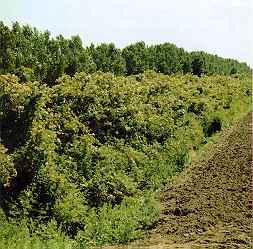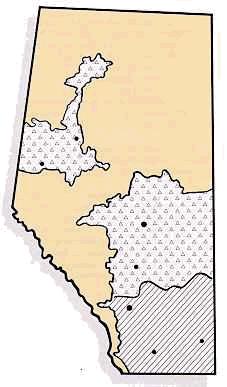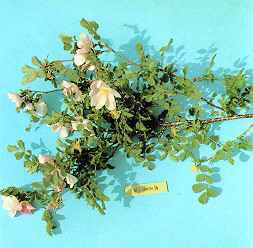| | Plant characteristics | Site preference | Hardiness | Uses | Problems | Diseases | Pruning
.

Scientific Name: Rosa gallica 'Alika'.
Plant Characteristics
Introduced from Asia, and naturalized in North America.
Upright shrub with creeping rootstock. Reaching a height at maturity of 2 to 3 m (6 to 10 ft), with a spread of 2 m (6 ft). The shrub has similar flowers to the wild rose of Alberta.
Hedge rose is a very long lived shrub, 25+ years. It can grow at a rate of 10 to 45 cm (4 to 18 in.) a year till maturity.
Leaves - The red stem is usually densely covered with prickles and bristles. Leaflets range from 3 to 5 broad- elliptic or oval, 2 to 6 cm (1 to 2.5 in.) long, leaves are dark green above and paler beneath, with a serrated edge.
Flowers - Solitary pink or crimson from 4 to 7 cm (1.5 to 3 in.) across on a rather long stout pedicel. Flowers in June.
Fruit - Brick red hips in September.
Site Preference
Hedge rose is adapted to a wide range of soils. It ranges from a moist well drained soil to a poorly drained soil. It can withstand flooding during the growing season, but prefers a rich loam soil.
Has a moderate drought resistance, the plant will survive while exposed to short periods of low moisture.
It is tolerant of some shade, but prefers full sun.
Hedge rose is quite salt tolerant.
Hardiness
May winter kill, susceptible to freezing and thawing.
.


Uses
Can be planted with poplars in a field shelterbelt. The limited height makes the shelterbelt value of the shrub insignificant. As an ornamental hedge the plant is useful for farmstead beautification. Recommended planting distance in the row is 1 to 1.5 m (3 to 4.5 ft) between plants. The fruit is a rose hip, which is readily eaten by birds. It can also provide protection for wildlife.
Problems
The plant suckers freely, which might be considered a nuisance.
Diseases
Hedge rose is susceptible to various leaf rusts, leaf spots, powdery mildew, stem cankers, and crown galls.
Pruning
Older hedges can readily be rejuvenated by cutting the plants down to ground level. The plant suckers freely, which might be considered a nuisance. Flowers are produced on new wood, so removal of very old wood will increase flowering. Remove - wide spreading branches to keep it in bounds.
.

Shelterbelts Varieties for Alberta provides information on a number of other trees and shrubs than may be suitable for shelterbelts.
Visit our website directory for the Reforestation Woodlot Listings |
|